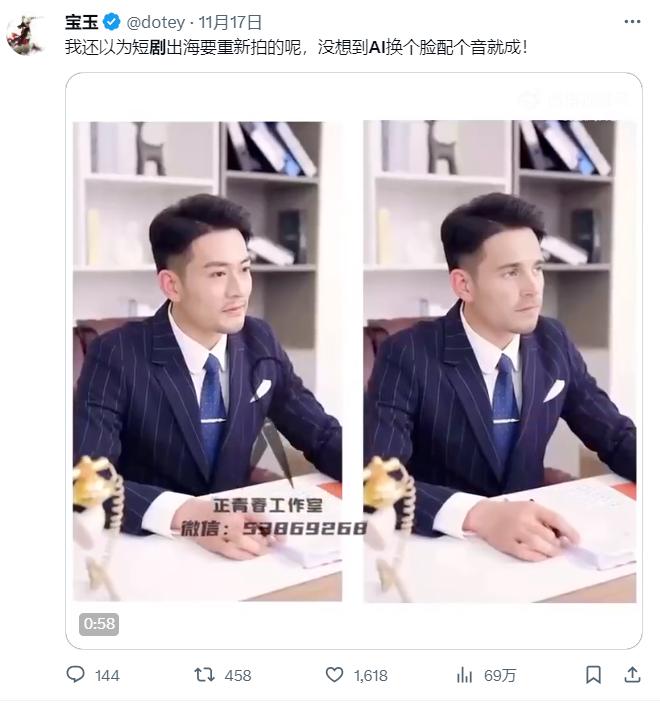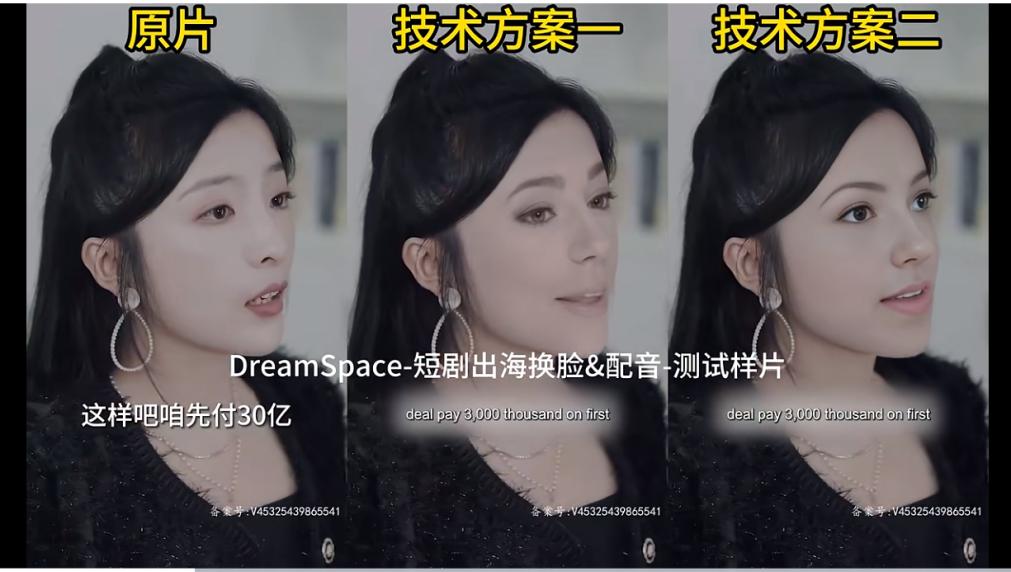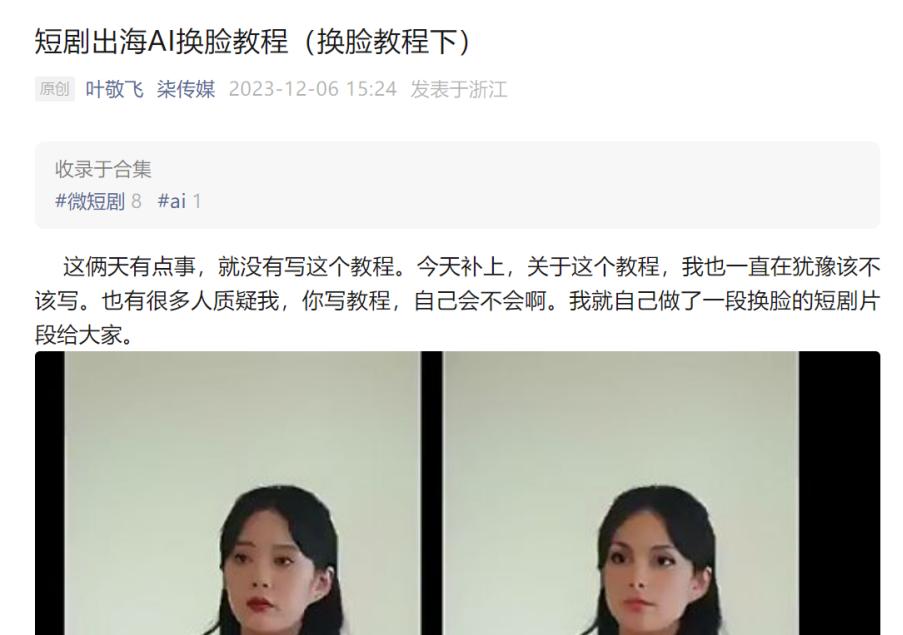A New 'Way Out': Using AI to Produce Overseas Short Dramas, Saving 600,000 Yuan per Production
-
Last month, a short drama clip using AI face-swapping technology suddenly began circulating in many short drama groups and on Twitter.
Leveraging AI, Chinese actors in the short drama were transformed into Western leads, with various subtle expressions and mannerisms quite on point. As soon as the video surfaced, many industry professionals became excited. Building on the existing model of translating short dramas for overseas markets, this low-cost approach to exporting short dramas appears poised to advance localization at the visual level.

Heygen's one-second language switching and lip-syncing, combined with AI face-swapping technology, could theoretically help rapidly distribute China's existing short drama inventory overseas, addressing the current production capacity gap (top overseas producers currently output 4-5 episodes monthly). However, after discussions with several technical service providers, we found reality remains relatively "harsh."
First, AI face-swapping + language/lip adaptation for repurposing domestic content essentially pursues marginal benefits. While AI face-swapping costs aren't prohibitively high currently, they're not negligible either. The uncertain revenue potential from additional investments creates ROI concerns for overseas expansion-minded producers.
More fundamentally, while face-swapping improves visual acceptance, short dramas' success hinges on cultural relevance and thematic alignment. Beyond universally appealing themes, face-swapping can't solve localization issues in plotlines, raising future monetization concerns - bringing us back to ROI calculations.
Nevertheless, savvy industry players are now exploring new approaches based on existing technologies and these identified challenges.
AI face-swapping is not a new technology, but it has been more commonly used in commercial fields such as film production and live streaming. It's hard not to admire the genius of the first person who thought of combining AI face-swapping with short dramas for overseas markets. The aforementioned face-swapping short drama might not be the first application of AI face-swapping in short dramas, but it has indeed become a catalyst for overseas short drama creators to start paying attention to AI face-swapping technology. Observing the social media posts of the original creator of the face-swapping video, he mentioned that there was a lot of interest, with hundreds of people adding him in just half a day.
It sounds lively, but after searching around on TikTok, the author found that there aren't many AI face-swapping short dramas in the overseas market at the moment. This observation aligns with the sentiments of a technical service provider, Mr. An, who noted, "There are many onlookers, but few are willing to test the waters." The main reason is the fear of not recouping the investment. In the market, the cost for AI face-swapping in short dramas typically ranges from 50,000 to over 100,000 RMB, with significant variations in technical pricing. "Lip-synced translation" is usually considered an additional service and requires extra payment, making the total cost quite substantial. If done well and comprehensively, the price could easily reach 200,000 RMB.
At present, the common practice of 'exporting domestic short videos' is through translation, typically adding foreign language subtitles. More sophisticated approaches include dubbing, though Text-to-Speech (TTS) is rarely used due to its unnatural effects. The head of Lingxiangniao Translation Company provided a quote: direct translation of short videos costs approximately 30 RMB per minute (including translation, subtitling, proofreading, and output processing). Adding human voice-over increases the cost to 300-400 RMB per minute. With these processes, the total cost for a single video can be kept under 10,000 RMB (excluding voice-over). Companies like Jiuzhou have their own AI translation systems, further reducing costs. According to a closed-door meeting by Jiuzhou, their costs can be as low as 100-200 RMB per video. Although the quality may be rougher, retaining Chinese faces and voices, overseas audiences can still understand the content. At such prices, exporting domestic short videos directly overseas is significantly cheaper. However, while these videos may have lower conversion rates abroad, they remain the preferred choice for budget-constrained producers.
Of course, cost isn't the only consideration. Another issue is that 'existing short videos may not suit foreign tastes.' This feedback aligns with our understanding of overseas audiences. Translated short videos are cost-effective but generate less enthusiasm for payment. AI face-swapping doesn’t address the core issue of 'localizing the plot' for existing videos, and the potential revenue boost from AI face-swapping remains uncertain. These factors make AI face-swapping currently more of a trial for high-quality short videos being exported, as large-scale adoption faces significant cost and recovery pressures.
However, during discussions with multiple technical service providers, the author unexpectedly learned about a strategy using AI face-swapping to create 'pseudo-overseas productions.' Producers bring overseas scripts to China for filming (using domestic actors), releasing the non-face-swapped version domestically and the face-swapped version overseas. This approach, even with AI face-swapping costs, is still cheaper than overseas production and simultaneously solves the issue of insufficient plot localization.
The high cost of overseas production is a common challenge mentioned by almost all short drama producers targeting international markets, especially in terms of filming. Traditionally, cost control in this area has focused on internal process optimization and selecting production teams outside the US, such as in less developed European economies like Romania. However, the idea of filming domestically and then using AI face-swapping was something the author hadn't previously considered.
Technology service provider Dream Space shared that this is a new service requested by their clients. "Our initial business was focused on digital humans and face-swapping for films and TV dramas. Recently, we've been approached by many short drama producers—about 7 to 8 companies," said Zhang Xu, the company's representative.
While there are foreign actors available domestically, as we've learned, many are already familiar faces in overseas advertisements, and issues like accents limit casting options. Zhang Xu explained, "With AI face-swapping technology, producers can hire skilled actors and then choose any face they want."
Even with a relatively high industry price of 200,000 RMB per production for face-swapping, this approach remains more cost-effective than traditional overseas production.
The cost of overseas self-produced content ranges from $150,000 to $250,000 (approximately ¥1.05 million to ¥1.75 million). On the domestic side, even with a production cost of ¥500,000 per drama and adding face-swapping expenses, the total cost is ¥700,000, saving at least several hundred thousand yuan.
Additionally, time is saved. Typically, the AI face-swapping and dubbing process for a single short drama takes 10 days. Including this step, the domestic production cycle is still nearly a month shorter than overseas.

Zhang Xu frankly stated that considering the cost, the face-swapping technology applied in short dramas actually differs from its use in big-screen movies. "The quality standards are different. Movies generally require 4K resolution, while 1080p is sufficient for short dramas, as we aim to control costs as much as possible." According to Zhang, their finished projects are expected to launch by mid-month, and the first batch of AI-enhanced 'pseudo-overseas self-produced' short dramas will soon undergo market testing.
It's worth noting that the threshold for AI face-swapping isn't particularly high. Even beginners can produce passable face-swapped videos using readily available AI tools. However, the handling of micro-expressions, lip-sync accuracy, and skin detail retention varies widely. These factors lead to significant price differences among service providers in the market. Generally, you get what you pay for, and producers need to balance budgets and manage expectations accordingly.

Under current production constraints, the overseas expansion of short dramas has already become intensely popular. It's foreseeable that with technological capabilities, more and more 'overseas-flavored' short dramas will be released. For example, recently, a domestic company called Jingying Technology announced securing millions in USD funding. According to their claims, their video generation model has achieved groundbreaking progress, and they plan to launch the first AI short drama app overseas.
However, as analyzed in our previous articles, even the leading short drama apps expanding overseas face issues like low user retention and reliance on hit-or-miss content. Additionally, problems such as homogenized content supply and aggressive user acquisition by top players persist. As a new wave of supply enters the market, we will continue monitoring which direction it pushes the industry.
